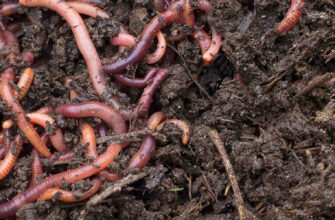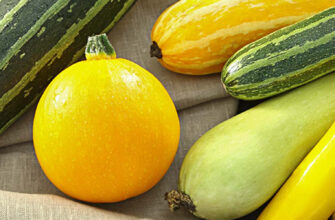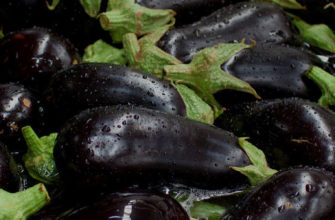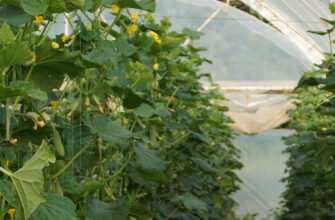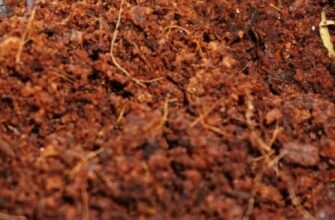Carrot (Daucus carota) is a biennial plant from the Apiaceae family. In the first year, it forms a rosette and a root crop, and in the second year, it produces a flower umbel and seeds. It is one of the most popular vegetables grown in Ukraine. Carrots are consumed fresh, used for processing, and stored throughout the winter season.
Carrots are rich in vitamin A and other beneficial nutrients, which makes them a valuable food crop. This article outlines the technology and specific features of growing carrots from sowing to harvest.
Biological Characteristics
Carrot is a cold-resistant crop that can tolerate temperatures as low as -5 to -3°C. The minimum temperature for seed germination is +4 to +6°C, while the optimal temperature for growth is between +18 and +25°C.
Carrot roots develop best at +18 to +21°C, while leaf growth is optimal at +23 to +25°C. High temperatures combined with insufficient watering can cause growth to stop, result in coarse and misshapen roots, and negatively affect taste.
Sometimes, carrots deviate from their biennial life cycle and produce a flower stalk in the year of sowing. This typically occurs after prolonged exposure to low temperatures following sowing, or due to high heat during early development.
Carrots are long-day plants. A lack of light halts growth and nutrient accumulation, significantly reducing overall root yield. Therefore, they should not be sown in shaded areas.
Carrots are sensitive to moisture at all growth stages, particularly during the period between sowing and seedling emergence, and during root development. However, the plant is resistant to air drought due to its dissected leaves and hairy stems, which reduce moisture loss.
Uneven watering during root formation can cause root cracking, while excess water promotes the growth of multiple lateral roots. Root bulking starts after leaf mass development—about one-third into the vegetation period.
Crop Rotation and Site Selection
Carrots should not be grown in the same field more than once every 3–4 years. Ignoring this can lead to decreased yields, the spread of diseases and pests, and poor storability of the harvested crop.
Ideal predecessors include winter wheat, legumes, tomatoes, cucumbers, cabbage, zucchini, radishes, onions, and garlic—especially those previously fertilized with fresh manure.
Carrots grow well near onions, peas, and strawberries. However, they should not be planted near potatoes, kohlrabi, or corn.
Poor predecessors include parsley, beets, celery, and potatoes.
Soil Requirements
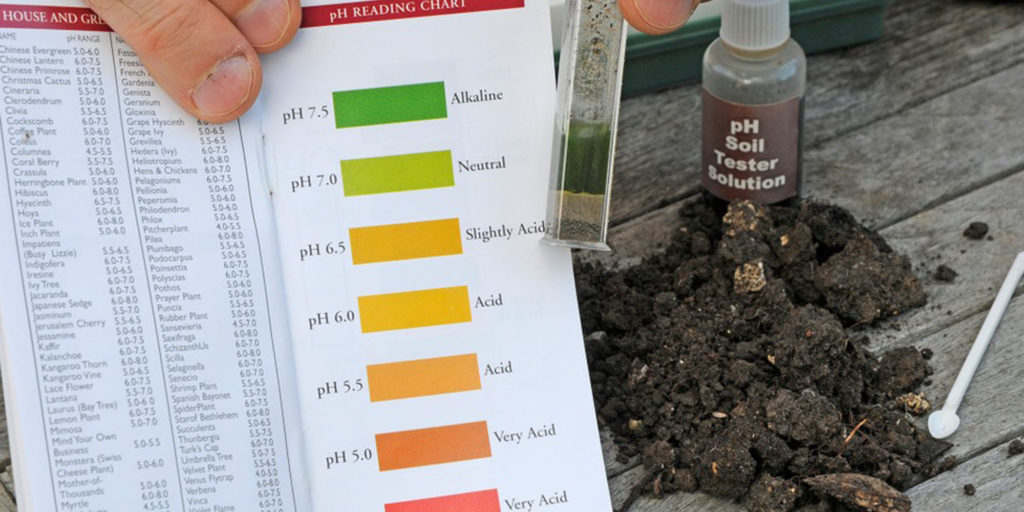
Carrots prefer loose, fertile soils. Light-textured soils warm up quickly, encourage proper root development, and ease harvest. Therefore, sandy, loamy sand, or light loam soils are ideal. The soil texture can be determined through laboratory analysis.
On heavy soils, carrots germinate poorly, grow slowly, are more prone to fungal diseases, and develop misshapen roots with poor taste.
Carrots can tolerate a pH range of 5.0 to 8.0, but the optimal soil acidity is between 6.0 and 6.8 pH. Saline soils inhibit seed germination, slow down carrot growth, and reduce nutrient availability. To lower soil acidity, apply lime or defecate in autumn. To combat salinity, phosphogypsum can be applied.
When selecting a field for carrot cultivation, pay attention to topography. Choose flat terrain or areas with a slight slope. Steep slopes risk seed or seedling washout during heavy rain, while depressions may accumulate water. These should be leveled in advance to avoid waterlogging.
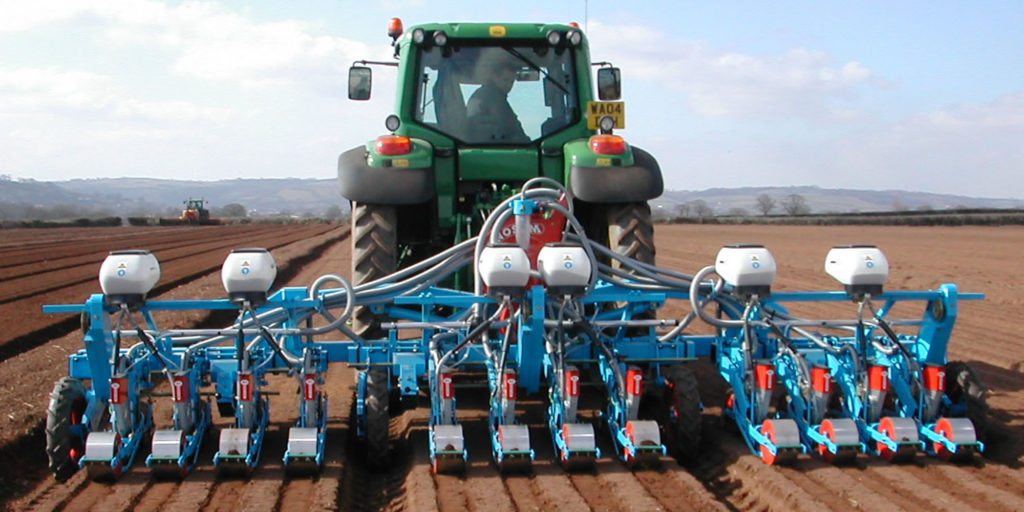
Fertilization
Carrots have medium nutrient requirements. To produce 1 ton of yield, the crop consumes approximately 2.63 kg of nitrogen, 1.2–1.5 kg of phosphorus, and 4.2–4.8 kg of potassium. Some of these nutrients remain in the soil after the previous crop.
Exact fertilizer rates can only be determined based on agrochemical soil analysis. Knowing the soil pH also allows for selecting fertilizers that maintain optimal soil acidity.
A key feature of carrot cultivation is the importance of potassium, which improves sugar content, flavor, and storage quality. Nitrogen should be applied cautiously, as overuse can cause coarse roots, excessive leaf mass, and nitrate accumulation.
On average, carrot fertilization includes 80–120 kg/ha of nitrogen (N), 50–80 kg/ha of phosphorus (P₂O₅), and 150–200 kg/ha of potassium (K₂O). The distribution of fertilizers depends on the irrigation method.
With surface irrigation, phosphorus and potassium fertilizers are applied in the fall. On heavy soils, potassium is applied in split doses—half in the fall and half before sowing. On light soils, the full dose of potassium can be applied before sowing.
Additionally, 50–70 kg/ha of nitrogen (active ingredient) is applied during pre-sowing cultivation. If nutrient deficiencies appear during the growing season, topdressing can be done 1–1.5 months after emergence.
Under drip irrigation, part of the phosphorus and potassium is applied in autumn (50–80 kg/ha P and 70–90 kg/ha K), with the rest through fertigation during growth
Tip: The introduction of increased nitrogen doses under carrots leads to the formation of a large number of tops, hardening and deterioration of the quality of root crops.
Carrot Varieties and Hybrids
There is a wide variety of carrot shapes, with the most common types being Nantes, Chantenay, Flakkee, and Berlikum. Ultra-early varieties mature in 60 days, while late varieties require 130–140 days.

Sowing Carrot Seeds
For early harvests, sow carrots as soon as possible after field preparation. In Ukraine, this typically occurs in late March to early April. Late carrots for storage are sown 2–3 weeks later (mid-April to late May). Since harvest takes place in September–October, sowing dates are based on the variety’s growing season.
Summer sowing is done after harvesting early crops (early cabbage, lettuce, radish, cucumber, beet for bunching). In this case, early varieties and hybrids are sown no earlier than July 20.
For cultivation without ridges, row or wide-row sowing is used—suitable for early carrots with small roots (e.g., Chantenay type). Depending on machinery, row spacing is 30–45 cm, with 2.5–3 cm between plants in the row.
Another method is belt sowing: four rows are sown 20–30 cm apart, with the next set spaced according to tractor wheel width. Within rows, plant spacing is 2.5–3.5 cm.
Carrots grow best on raised beds. On each bed, two seed rows are sown with 65–75 cm between beds and 6 cm between rows.
Sowing depth is 1.5–2 cm. Seeds are sown using precision or hand seeders. If the seeder lacks press wheels, rolling must be done after sowing.
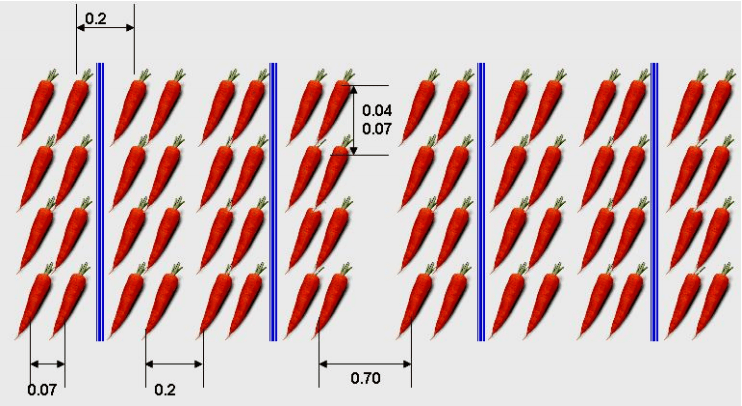
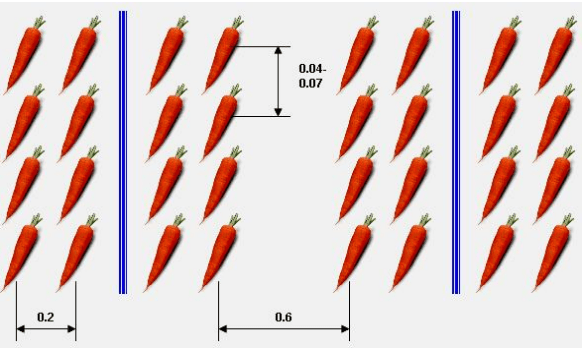
Seeding rate depends on carrot type and purpose:
- Autumn sowing: 1.5–2.0 million seeds/ha
- Early/bunched produce: 0.8–0.9 million seeds/ha
- Fresh market and storage: 1.0–1.4 million seeds/ha
- Processing: 1.0–1.2 million seeds/ha
Too low a density—especially for late carrots—may cause roots to crack.
Commercial seeds are pre-disinfected and require no additional treatment before sowing.
Irrigation should begin immediately after sowing. Carrot seeds swell and germinate slowly, with the first sprouts appearing no sooner than 14–21 days later.
For summer sowing, keep the soil consistently moist until emergence. Do not let the soil dry out, or the sprouts will die.
Crop Care
During carrot growth, timely fertilization, inter-row cultivation, and protection from weeds, diseases, and pests are essential. Throughout the growing season, 5–6 inter-row cultivations are performed to eliminate soil crust and improve aeration.
Inter-row cultivation can begin at the 6–8 leaf stage and continue until canopy closure. The first cultivation is done to a depth of 4–6 cm, with subsequent passes reaching up to 12 cm.
Irrigation
Moisture is critical for carrot growth from seedling emergence to root formation. During this period, the moisture level of the top 50 cm of soil should be maintained at 80% of field capacity. During root formation, it can be reduced to 70%.
Several irrigation methods can be used for carrots:
- Drip irrigation — the most effective method, as water is delivered directly to the soil, avoiding foliage and reducing disease risk. Fertilizers and pesticides can also be applied through this system.
- Sprinkler irrigation — simulates rainfall using sprinklers; popular for small-scale vegetable production.
- Micro-sprinkling — creates optimal air humidity and conditions for carrot growth using fine water droplets.
- Overhead irrigation machines — including frontal systems (Volzhanka, Bauer), radial (Fregat, Dnipro), reel-type, and mounted systems (DDA-100).
Total water consumption for carrot crops is around 4,000–5,500 m³/ha. In the first half of the growing season, irrigation is done every 8–10 days; later, every 14–20 days.
It is best to irrigate lightly — at 300–350 m³/ha. With drip irrigation, apply 20–30 m³/ha per day in early stages; in hot weather, carrots may need up to 50 m³/ha daily. Irrigate every 2–3 days.
Before root formation, carrots should be watered frequently in small doses to maintain optimal moisture levels. As the roots develop, increase irrigation volume and extend the intervals between waterings.
Inconsistent moisture and nutrition can lead to cracked, deformed, and stubby roots. Cracking most often occurs after heavy rain or high irrigation rates following drought. Therefore, maintaining consistent soil moisture is crucial.
Weed Control
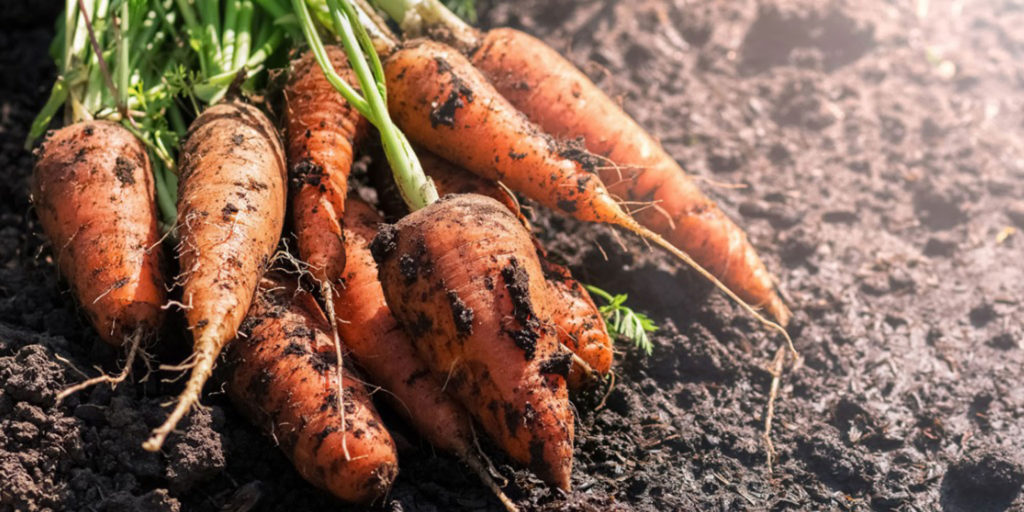
Weeds suppress the development of tender seedlings and deplete the soil of nutrients needed by carrot plants. A major challenge in carrot farming is the limited availability of herbicides approved for this crop.
Therefore, when choosing a field for carrot sowing, it’s important to assess the dominant weed species. If the field is heavily infested, control should begin in the fall with products like Tornado 500 or Roundup.
Within a week after sowing, apply pre-emergent herbicides such as Gesagard 50%, Stomp 330, Gambit, or Targa Super. These prevent weeds from sprouting for an extended period.
Once carrot seedlings reach the 2–4 true leaf stage, apply Gesagard 50% or Positive Plus (if they are allowed in your country). During the growing season, carrots are treated 2–3 times with grass-targeting herbicides like Achiba, Furore Super, Centurion, or Targa Super.
Apply herbicides using a working fluid rate of 250–300 L/ha. Herbicide efficacy increases on pre-moistened soil, so irrigate one day before application.
Moist soil helps form a protective barrier for pre-emergent herbicides and slows evaporation for post-emergent ones, extending their activity.
In bunch carrot production (early harvest), herbicides are used only before emergence due to the crop’s short growing period.Tip: Always apply treatments in windless weather at temperatures between +10°C and +25°C.
Tip: Always apply treatments in windless weather at temperatures between +10°C and +25°C.
Pest and Disease Control
Carrots affected by pests or diseases show reduced yield and shelf life. Maintaining a clean crop is essential.
The most common carrot pests include the carrot fly, moths, wireworms, aphids, leafhoppers, and thrips. Insecticides registered for carrots are used for control.
Against the carrot fly, use Borey, ZhukOFF, Presto, Anshlag, or Stop Zhuk. For moths, use ZhukOFF or Anshlag.
Common carrot diseases include powdery mildew, Alternaria, Rhizoctonia, and root rot.
Harvesting
Carrots are harvested when they reach the desired size and the foliage changes color. Harvesting can be manual or mechanized. Stop irrigation 2–3 weeks before harvesting to prevent root cracking. For early or bunch carrots, this dry period is shorter.
Bunch carrots are harvested when roots reach 1.0–1.5 cm in thickness and 5–6 cm in length. Carrots are shaken free of soil and tied in bunches of 10–15 pieces.
Carrots for the fresh market and storage are harvested semi-mechanically. Roots are loosened with special tools and manually collected into nets or sacks. In autumn, carrots are left in the field for a day to dry before being stored.
In summer, harvested carrots are transported and cooled immediately to avoid dehydration, which reduces shelf life.
Carrots for processing can be harvested mechanically using machines that lift the roots by the foliage.
Mechanical Harvesting
For this method, carrots must have strong leaf mass. Ideal harvesting conditions include cool temperatures around +8°C. Carrots are immediately loaded into containers and transported to storage.

If you have found a spelling error, please, notify us by selecting that text and pressing Ctrl+Enter.

